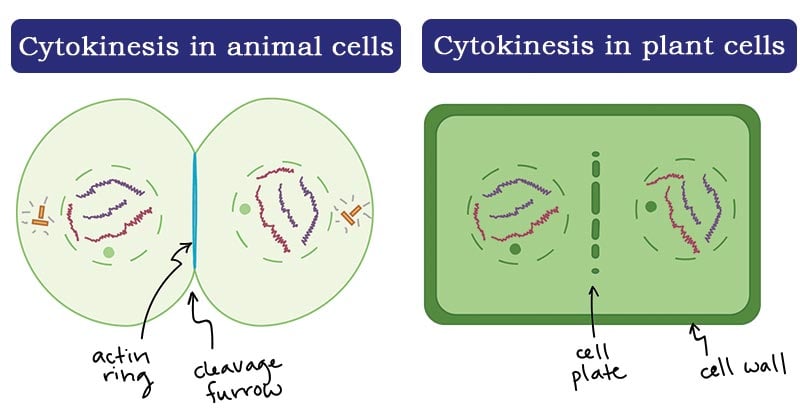Explain When Cytokinesis Is Different in Plants and Animals
See how this plays out inside a cell. Enter the email address you signed up with and well email you a reset link.

Difference Between Cytokinesis In Plant And Animal Cytokinesis In Animal Cells Vs Plant Cells 431x321 Png Download Pngkit
Sign up for our email announcements.
. Click here to sign up. However during the 19th century this classification was challenged by numerous pieces of evidence that were just too insufficient to explain such diversity. Plants animals fungi slime moulds protozoa and algae are all eukaryoticThese cells are about fifteen times wider than a typical prokaryote and can be as much as a thousand times greater in volume.
In plants certain structures aimed to attract one type of pollinator simultaneously prevent a different pollinator from accessing the pollen. Adult plants and animals can have young. In many kinds of animals parents and the offspring themselves engage in behaviors that help the offspring to survive.
Marsupials in Australia - See you take home quiz. Different versions of a gene alleles can code for proteins that work a little differently. Close Log In.
The main distinguishing feature of eukaryotes as compared to prokaryotes is compartmentalization. Mitosis and meiosis are the two ways by which cells reproduce. In animals ranging from insects to humans males produce sperm in testes and sperm are stored in the epididymis until.
Growing plants gizmo answer key activity a. Plants perform cytokinesis differently than animals because a. The fossil record - Example transitional forms like Archaeopteryx.
The S phase is the second phase of interphase during which the DNA of the chromosomes is replicated. This lesson results from the ALEX Resource Gap Project. Plants and animals grow and change.
Log in with Facebook Log in with Google. The tunnel through which an animal must access nectar can vary in length and diameter which prevents the plant from being cross-pollinated with a different species. See you take home quiz.
Most animals and plants are diploid containing two sets of chromosomes. Depending upon chromosomal number reduced or not. - Endemic finches on the Galapagos Islands.
Plant chromosomes are more difficult to separate than animal chromosomes. See you text 1. They will also acknowledge that all food chains start with energy from the sun.
The reproductive structures of many animals are very similar even across different lineages in a process that begins with two gameteseggs and spermand ends with a zygote which is a fertilized egg. Raven Biology of Plants. A primitive form of cell division is also found which is called amitosisThe amitotic or mitotic cell division is more atypical and diverse.
The G 1 phase which is also called the first gap phase is the first phase of the interphase and is focused on cell growth. Cytokinesis is a concluding process to cell division where the parent cell after undergoing the different phases of cell division divides to form new daughter cells. Life on Earth is genuinely very diverseHence to easily distinguish living organisms early scientists classified them into two kingdoms.
The presence of membrane-bound organelles compartments in which. They will construct a model of a food chain to explain that energy in animals food is used to sustain life. As a result they share several steps in their respective processes.
Meiosis is preceded by an interphase consisting of the G 1 S and G 2 phases which are nearly identical to the phases preceding mitosis. Genetic variations can provide clues about common ancestry. Meiosis adds another division and a step that mixes the genetic material from the parent cells but in both cases the cell must duplicate its DNA pull it apart into two sets place the sets on each end of itself and then divide down the middle.
Remember me on this computer. It is also called an equational division as the number of parent and progeny cell chromosomes is identical. Cell division in eukaryote is much more complicated than prokaryote.
Plant cytokinesis takes place during interphase but animal cytokinesis takes place in cell division. Growing plants gizmo answer key activity a. In animals the division of mitotic cells is only seen in the diploid somatic cells while mitotic divisions in both haploid and diploid cells can be seen in the plants.
By the end of grade 5. Plants and animals have predictable characteristics at different stages of development. Eukaryotic cell divisions can be classified as mitosis equational division and meiosis reductional division.
List an explain 4 different lines of evidence in support of evolution. Animalia animals and Plantae plants. Cytokinesis in Plant Cells.
Somatic cells are sometimes referred to as body cells. Students will discover how plants animals and fungi are all interconnected in a giant web. In each somatic cell of the organism all cells of a multicellular organism except the gametes or reproductive cells the nucleus contains two copies of each chromosome called homologous chromosomes.
Mitosis is Subdivided into the Following 4 Stages. In nearly all species cytokinesis separates the cell contents by either a cleavage furrow in animals and some fungi or a cell plate that will ultimately lead to the formation of cell walls that separate the two daughter cells in. Cytokinesis the physical separation of the cytoplasmic components into two daughter cells occurs without the reformation of the nuclei in other organisms.

Cytokinesis Definition And Process In Animal And Plant Cells

Difference Between Plant And Animal Cytokinesis Compare The Difference Between Similar Terms
What Is The Difference Between Cytokinesis In Animal And Plant Cells Quora
Comments
Post a Comment